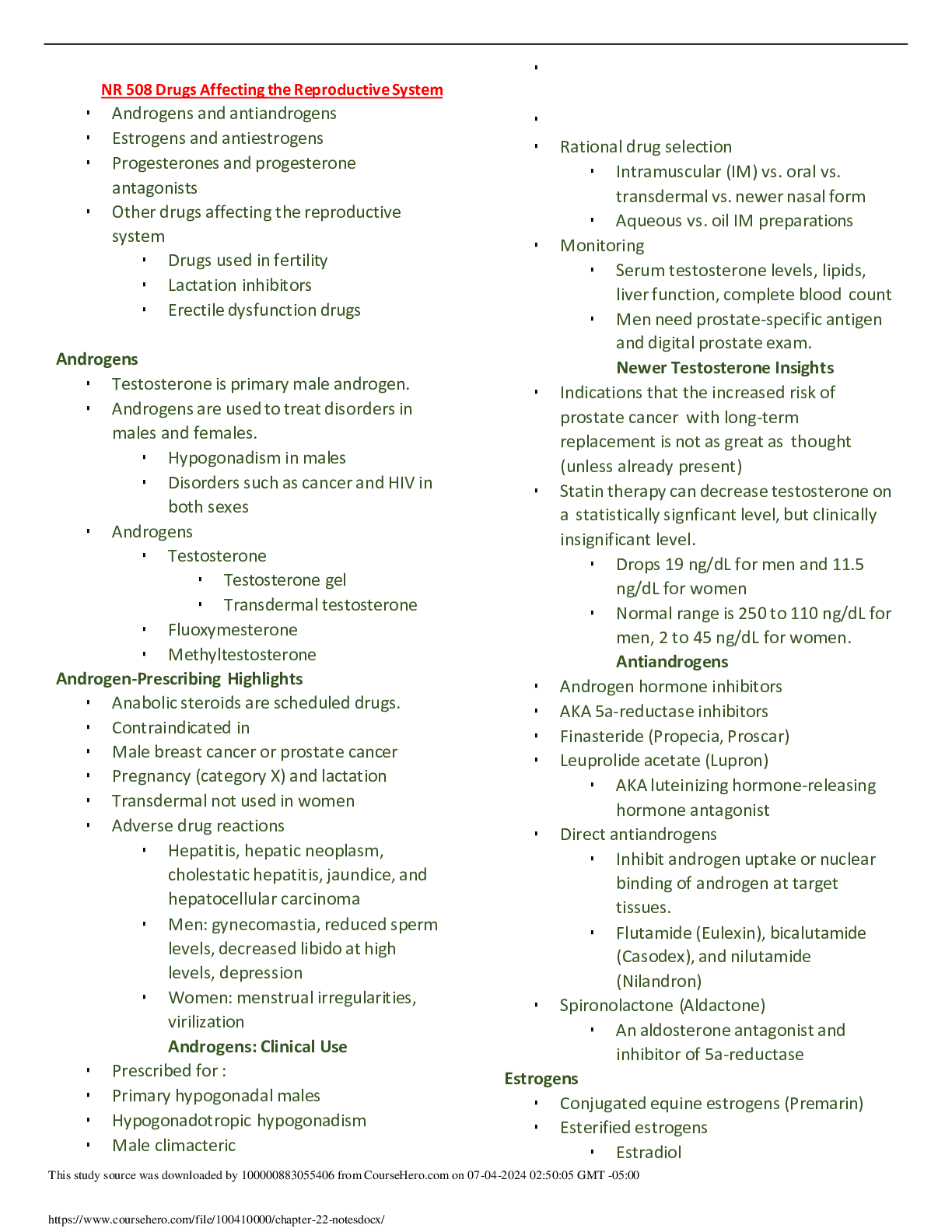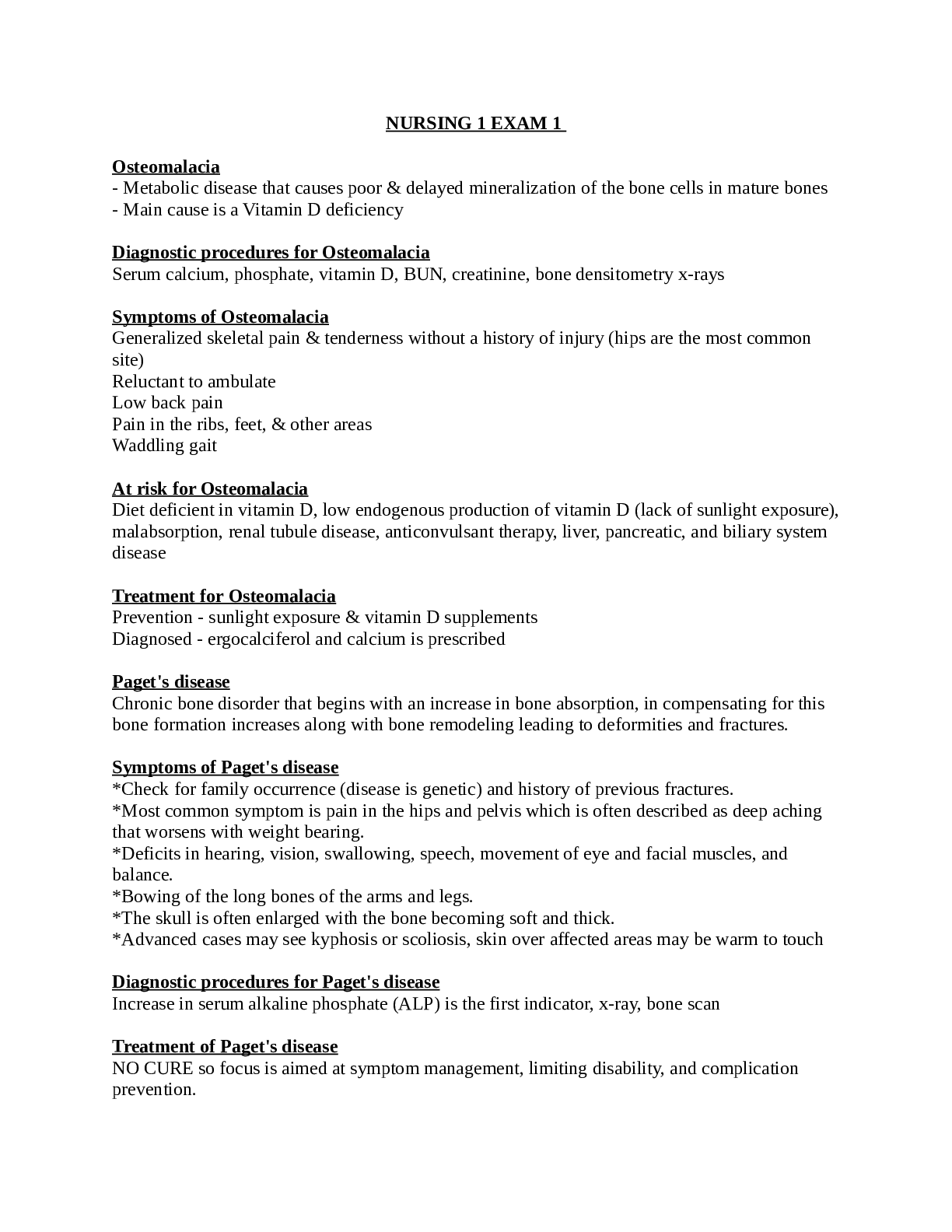Pharmacology for Nursing Care > Class Notes > NR 508 Drugs Affecting the Reproductive System - Download For Revision To Score An A+ (All)
NR 508 Drugs Affecting the Reproductive System - Download For Revision To Score An A+
Document Content and Description Below
NR 508 Drugs Affecting the Reproductive System ▪ Androgens and antiandrogens ▪ Estrogens and antiestrogens ▪ Progesterones and progesterone antagonists ▪ Other drugs affecting the reproduc... tive system ▪ Drugs used in fertility ▪ Lactation inhibitors ▪ Erectile dysfunction drugs Androgens ▪ Testosterone is primary male androgen. ▪ Androgens are used to treat disorders in males and females. ▪ Hypogonadism in males ▪ Disorders such as cancer and HIV in both sexes ▪ Androgens ▪ Testosterone ▪ Testosterone gel ▪ Transdermal testosterone ▪ Fluoxymesterone ▪ Methyltestosterone Androgen-Prescribing Highlights ▪ Anabolic steroids are scheduled drugs. ▪ Contraindicated in ▪ Male breast cancer or prostate cancer ▪ Pregnancy (category X) and lactation ▪ Transdermal not used in women ▪ Adverse drug reactions ▪ Hepatitis, hepatic neoplasm, cholestatic hepatitis, jaundice, and hepatocellular carcinoma ▪ Men: gynecomastia, reduced sperm levels, decreased libido at high levels, depression ▪ Women: menstrual irregularities, virilization Androgens: Clinical Use ▪ Prescribed for : ▪ Primary hypogonadal males ▪ Hypogonadotropic hypogonadism ▪ Male climacteric ▪ ▪ ▪ Rational drug selection ▪ Intramuscular (IM) vs. oral vs. transdermal vs. newer nasal form ▪ Aqueous vs. oil IM preparations ▪ Monitoring ▪ Serum testosterone levels, lipids, liver function, complete blood count ▪ Men need prostate-specific antigen and digital prostate exam. Newer Testosterone Insights ▪ Indications that the increased risk of prostate cancer with long-term replacement is not as great as thought (unless already present) ▪ Statin therapy can decrease testosterone on a statistically signficant level, but clinically insignificant level. ▪ Drops 19 ng/dL for men and 11.5 ng/dL for women ▪ Normal range is 250 to 110 ng/dL for men, 2 to 45 ng/dL for women. Antiandrogens ▪ Androgen hormone inhibitors ▪ AKA 5a-reductase inhibitors ▪ Finasteride (Propecia, Proscar) ▪ Leuprolide acetate (Lupron) ▪ AKA luteinizing hormone-releasing hormone antagonist ▪ Direct antiandrogens ▪ Inhibit androgen uptake or nuclear binding of androgen at target tissues. ▪ Flutamide (Eulexin), bicalutamide (Casodex), and nilutamide (Nilandron) ▪ Spironolactone (Aldactone) ▪ An aldosterone antagonist and inhibitor of 5a-reductase Estrogens ▪ Conjugated equine estrogens (Premarin) ▪ Esterified estrogens ▪ Estradiol ▪ Ethinyl estradiol ▪ Phytoestrogens ▪ Effects of estrogen ▪ Bone density ▪ Normal skin and blood vessel structure ▪ Lipids ▪ Reduces bowel motility ▪ Enhances coagulability of blood ▪ Causes edema due to its action on the renin-angiotension system ▪ Maintains stability of the thermoregulatory center Estrogen: Prescribing Highlights ▪ Estrogen-only products are contraindicated in women with an intact uterus. ▪ Contraindicated in ▪ Pregnancy (category X) ▪ Breast cancer ▪ Estrogen-dependent neoplasia ▪ Active deep vein thrombosis or pulmonary embolism ▪ History in past year of stroke or myocardial infarction ▪ Liver dysfunction ▪ Smokers Estrogens: Clinical Use ▪ Contraception ➢ Combination of estrogen and progestin ▪ Relief of peri- and postmenopausal symptoms ▪ Start on lowest dose. ▪ Do not give unopposed estrogen to women with a uterus. ▪ See Hormone Replacement chapter for full information. ▪ Vaginal atrophy and dryness ▪ Vaginal cream, tablets, or ring ▪ Osteoporosis Antiestrogens ▪ Clomiphene (Clomid) ▪ Used to initiate ovulation in normogonadotropic, normoprolactinemic, and anovulatory patients ▪ Danazol (Danocrine) ▪ Used to treat endometriosis ▪ Tamoxifen (Nolvadex) ▪ Selective estrogen receptor modulator ▪ Adjuvant therapy for breast cancer in patients with estrogen-receptor – positive tumors ▪ Raloxifene (Evista) ▪ SERM used for osteoporosis Estrogen Agonists/Antagonists ▪ Newer marketed dyspareunia medications have selective estrogen effects. ▪ Possible positive impact on breasts ▪ Known uterine lining development, but much less than estrogen ▪ Helpful for those who cannot take progestins Progesterones ▪ Progesterones ▪ Progesterone (Promethrium, Progesterone in Oil, Crinone, Prochieve) ▪ Medroxyprogesterone acetate (Provera, Depo-Provera) ▪ Norethindrone (Aygestin) ▪ Megestrol acetate (Megace) ▪ Androgen-derived progestins ▪ Norethindrone, norethindrone acetate, ethynodiol diacetate, norgestrel, desogestrel, levonorgestrel, and norgestimate. ▪ Drospirenone is a progestin developed as a derivative of spironolactone. Progesterones: Prescribing Highlights ▪ Precautions and contraindications ▪ Thromboembolic disease ▪ Breast cancer ▪ Impaired liver function ▪ Depression ▪ Disorders that worsen with fluid retention ▪ Progesterone is pregnancy category D. ▪ Norethindrone acetate is pregnancy category X. Progesterones: Adverse Drug Reactions ▪ Irregular bleeding ▪ Amenorrhea ▪ Acne ▪ Injectable and inplanted progesterone ▪ Weight gain ▪ Irregular menstrual bleeding ▪ Osteoporosis Progesterones: Clinical Use ▪ Postmenopausal hormone replacement ▪ Combined with estrogen when uterus is intact ▪ Progestin-only contraception ▪ Progestin-only pills (norethindrone) ▪ Medroxyprogesterone acetate (Depo-Provera) ▪ Progestin implanted intrauterine device (Mirena) ▪ Monitoring ▪ Depression ▪ Seizure patients may have increased risk of seizures. ▪ Diabetics should monitor blood glucose. Progestin Antagonists ▪ Mifepristone (Mifeprex) ▪ Inhibits the activity of both endogenous and exogenous progesterone; without progesterone to maintain the pregnancy, termination results. ▪ Mifepristone will act as an abortifacient when used in conjunction with misoprostol during the first 7 weeks of pregnancy. Fertility Drugs ▪ Gonadotropin-releasing hormone ▪ A stimulant in pulsatile doses if the patient has a functional pituitary gland and an ovary to produce the luteinizing hormone surge initiating ovulation ▪ Also used to treat endometriosis and uterine fibroids, and to suppress prostate cancer ▪ Human menopausal gonadotropin: follitropin (Fertinex), menotropins (Pergonal, Humegon) ▪ Men: stimulate spermatogenesis ▪ Women: stimulates the maturation of follicules and ovulation Lactation Suppression Drugs ▪ Bromocriptine (Parlodel) ▪ Has an inhibitory effect on the pituitary gland that produces prolactin ▪ Begins to work within 2 hours ▪ Many drug interactions Erectile Dysfunction Drugs ▪ Phosphodiesterase type 5 inhibitors ➢ Sildenafil citrate (Viagra), tadalafil (Cialis), vardenafil (Levitra) ▪ Contraindicated ▪ In patients using nitrates due to a risk of severe, even fatal hypotension ▪ Alpha blockers have additive hypotension ▪ PDE5 inhibitors ▪ Small studies in women are inconclusive. ▪ Used in neonatal intensive care unit for persistent pulmonary hypertension [Show More]
Last updated: 1 year ago
Preview 2 out of 4 pages

Loading document previews ...
Buy this document to get the full access instantly
Instant Download Access after purchase
Buy NowInstant download
We Accept:

Reviews( 0 )
$12.00
Can't find what you want? Try our AI powered Search
Document information
Connected school, study & course
About the document
Uploaded On
Jul 04, 2024
Number of pages
4
Written in
Additional information
This document has been written for:
Uploaded
Jul 04, 2024
Downloads
0
Views
76




